I - Anatomy of the Chest Wall and Lungs
Editors: Shields, Thomas W.; LoCicero, Joseph; Ponn, Ronald B.; Rusch, Valerie W.
Title: General Thoracic Surgery, 6th Edition
Copyright 2005 Lippincott Williams & Wilkins
> Table of Contents > Volume I - The Lung, Pleura, Diaphragm, and Chest Wall > Section I - Anatomy of the Chest Wall and Lungs > Chapter 2 - Embryology of the Lungs
Chapter 2
Embryology of the Lungs
David H. Harpole Jr.
Thomas A. Aloia
The field of embryology is rich in important investigators and scientific breakthroughs, and the history of pulmonary embryology is no exception. As with other areas of human embryology, the first theories regarding lung development were derived from animal models. Embryologists including Krogh (1904), Pattle and Hopkinson (1963), and Hugues (1967) focused their early work on fish, amphibians, and birds. With a solid understanding of the evolution of air-breathing species, later work such as that by Witschi (1956) was focused on mammals and primates.
Many of the developmental principles and timelines elucidated by animal embryologists were directly applied to human lung development. Most of these principles furthered our understanding of human lung embryogenesis, but others were ultimately not applicable to the human model and stalled advancement in the field. For example, the fact that pulmonary development in the rhesus monkey is more rapid than that of the human led some to miscalculate the timing of important human embryologic milestones. In 1965, Lynne M. Reid commented that, Work on the human lung has been bedrilled for the last 50 years with unjustified extrapolations from animal work to man. Despite these setbacks, we currently have a very clear picture of pulmonary development in the human.
Important contributions to human pulmonary embryology have been made by a number of individuals. In 1936, Dubreuil devised the first system of nomenclature for pulmonary development. Concurrently, Congdon, as well as Streeter (1945a, 1945b, 1948, 1951), working at the Carnegie Institute during the first half of the 20th century, were able to document systematically pulmonary development in relation to development of the fetus as a whole. Over the next twenty years, several embryologists, including Loosli and Potter (1951), Bucher and Reid (1961), Boyden and Tompsett (1965), and Hislop and colleagues (1972), made major contributions specific to pulmonary development. We are particularly indebted to Boyden for advancing the technique of wax modeling of the bronchial tree and vasculature. More recently, Campiche and associates (1963) and Thurlbeck (1988) have made important advances in related fields.
Breakthroughs made by these and other researchers have not been made in a vacuum. Their contributions to clinical medicine have been pivotal to our understanding of both pediatric and adult lung function and pathology. For example, the discovery of surfactant and its role in lung function has led to the routine use of inhaled surfactant in the neonatal intensive care unit, substantially decreasing the morbidity and mortality of prematurity. As discussed at the end of this chapter, pulmonary embryology research continues to be a rich area of study with great translational potential. It is hoped that continued work on pulmonary development will yield many more meaningful therapeutic strategies for the treatment of both surgical and medical pulmonary disease.
This chapter is intended to provide a framework for subsequent chapters in this text by detailing embryonic pulmonary development. Clinical correlations will be provided when relevant to intrauterine events. Although much of the chapter focuses on prenatal pulmonary development, it is important to note that pulmonary morphogenesis and differentiation do not end at birth. Significant alveolar remodeling and growth occur during childhood. The development of the lung in humans certainly extends to the age of 8 years and may continue beyond this mark in some individuals.
In this chapter, significant events are marked using crown rump length and Carnegie stage after Streeter (1945a, 1945b, 1948, 1951). All dates given are timed from ovulation unless otherwise specified.
PULMONARY PARENCHYMAL EMBRYOGENESIS
Development of the pulmonary parenchyma has been thoroughly investigated and has been divided into a number of phases by various authors and governing bodies (Table 2-1). Dubreuil and associates (1936) divided prenatal pulmonary development into glandular and canalicular phases. Later, Loosli and Potter (1951) modified this system, renaming
P.17
the period from 6 months' gestation until birth as the alveolar period. Boyden (1972a), based on his studies of histology and wax models, defined a pseudoglandular phase from 5 weeks to 16 weeks, an overlapping canalicular phase from 13 to 24 weeks, and a terminal sac period from 25 weeks until birth. In this system the term alveolar is confined to postnatal pulmonary development. In 1970, the Commission on Embryological Terminology ratified Boyden's phase schema and added an embryonic period.
Table 2-1. Developmental Schema in Pulmonary Embryology and Their Authors | ||||||||||||||||
|---|---|---|---|---|---|---|---|---|---|---|---|---|---|---|---|---|
|
Recently, Thurlbeck (1988) described a system that divides Boyden's final stage, the terminal sac period, into a saccular period and an alveolar period based on late gestational alveolar maturation. In their most recent text, O'Rahilly and Muller (1996), taking into account the variability in the timing of events that define each stage, present a flexible schema of overlapping phases that is probably most accurate (Fig. 2-1). The system used in this chapter is that of the Commission on Embryological Terminology with minor modification by the system introduced by Thurlbeck in 1988.
Embryonic Phase
Smith (1957) first identified the formation of the tracheoesophageal groove in the foregut of a 3-mm, Carnegie stage 10 fetus. This development, which begins early in week 4, is summarized in Fig. 2-2. At this point, the cranial ventral foregut has enlarged, and an invaginating ridge of endodermal tissue has formed tracheoesophageal folds. The folds meet in the midline, defining a dorsal esophageal lumen and a ventral laryngotracheal primordia. Fusion of the tracheoesophageal folds then progresses from caudad to cephalad. Subsequent necrosis and degeneration of intervening tissue allows separation of the esophagus and trachea. As the trachea and esophageal primordia separate, both are elongating. Complete separation will not be achieved until about day 41 (stage 17, 11 to 14 mm). According to Zackary and Emery (1961), incomplete separation at this phase is the precursor for tracheoesophageal fistulae and their associated anomalies.
 |
Fig. 2-1. Overlapping phases in the development of the lung according to current thought. From O'Rahilly R, Muller F: Human Embryology and Teratology. 2nd Ed. New York: Wiley-Liss, 1996, p. 266. With permission. |
The primordial lung bud develops from the distal end of the newly formed trachea. O'Rahilly and Boyden (1973) first visualized the lung bud in a day-26 (stage 12, 4 mm) fetus, marking the beginning of the embryonic phase of lung development. The embryonic phase, which spans postovulatory days 26 to 52, focuses on the morphogenesis of the proximal airways and the early differentiation of adjacent mesenchymal tissue.
Shortly after the development of the lung bud, right and left lung primordia are seen. As the embryonic mediastinum develops, the left lung main bronchus assumes a shorter and more horizontal orientation. This asymmetry appears to be independent of mechanical influences from the developing heart, which will not occupy its final position in the mediastinum until the seventh week. Axial growth, as well as dichotomous division of the airways, continues during the embryonic phase (Fig. 2-3). By 52 days after ovulation (stage 22, 23 to 28 mm), secondary bronchi are visualized, marking the end of the embryonic phase and the beginning of the pseudoglandular phase of development.
Pseudoglandular Phase
As the pulmonary primordia move from the embryonic phase to the pseudoglandular phase, the bronchi continue to grow and mature. Histologically, the bronchi are lined with a glycogen-laden, cuboidal epithelium, giving the growing lung a glandular appearance. The period of time when this characteristic appearance of the lung is present spans weeks 5 through 17 of pulmonary embryogenesis and is termed the pseudoglandular phase, as suggested by Boyden (1972a). Although the embryonic phase focused on tracheal and lung bud development, the pseudoglandular phase focuses on the proliferation of endothelial, mesenchymal, and surrounding
P.18
P.19
structures, including the conducting airways, the pulmonary vasculature, and the diaphragm.
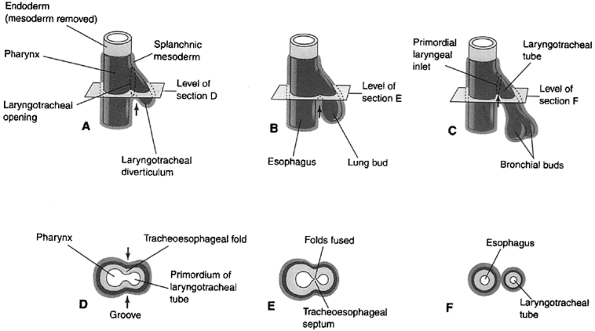 |
Fig. 2-2. Drawings illustrating successive stages in the development of the tracheoesophageal septum during the fourth and fifth weeks. A C. Lateral views of the caudal part of the primordial pharynx showing the laryngotracheal diverticulum and partitioning of the foregut into the esophagus and laryngotracheal tube. D F. Transverse sections illustrating formation of the tracheoesophageal septum and showing how it separates into the laryngotracheal tube and esophagus. From Moore KL, Persaud TVN: The Developing Human: Clinically Oriented Embryology. 6th Ed. Philadelphia: WB Saunders, 1998, p. 259. With permission. |
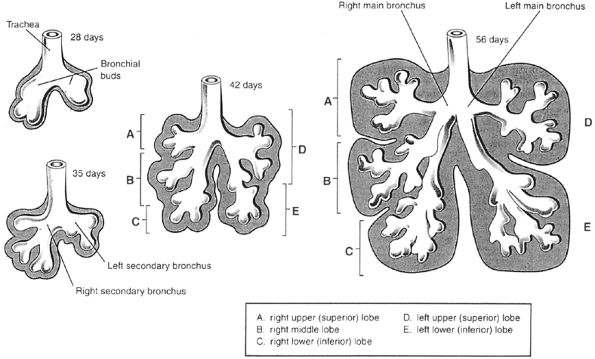 |
Fig. 2-3. Successive stages in the development of the bronchi and lungs. From Moore KL, Persaud TVN: The Developing Human: Clinically Oriented Embryology. 6th Ed. Philadelphia: WB Saunders, 1998, p. 263. With permission. |
During the embryonic phase of development, poorly differentiated mesenchyme derived from the splanchnic mesoderm envelops the pulmonary primordia. The developing lung is dependent on the presence of this mesenchyme. Studies by Rudnick (1933) and Taderera (1967) have shown that both bronchial branching and pulmonary endothelial development will not properly occur in the absence of species-specific mesenchyme. As the lung moves into the pseudoglandular phase of development, this mesenchyme differentiates into vascular and other stromal connective tissue elements. Early in the pseudoglandular period, vascular plexuses arising from the mesenchyme are seen forming around the lung bud. By the end of the pseudoglandular phase, vascular development is well under way, and connections to the developing heart have formed.
Late in the pseudoglandular period, bronchial support structures are seen. A ringed cartilaginous exoskeleton was visualized by Bucher and Reid (1961) at the level of the trachea by week 10 and around segmental bronchi by week 16. The bronchi are not only elongating throughout this phase, but they are also branching. In the right chest, the right main-stem bronchus bifurcates twice, forming three secondary bronchi. These bronchi, along with their surrounding mesenchyme, will form the right upper, middle, and lower lobes. On the left, a single major dichotomous branching occurs, forming the upper lobar bronchus, whereas the main bronchus terminates as the left lower lobe. Another round of dichotomous branching leads to the development of 18 total tertiary branches called bronchopulmonary segments, 10 right and 8 left.
Dichotomous branching at the terminus of each tertiary bronchus proceeds throughout the remainder of the pseudoglandular phase. Most of this branching takes place between weeks 10 and 16. By the end of the sixteenth week, Bucher and Reid (1961) were able to identify between 4 and 25 generations of conducting airways, depending on the location of the segment. This subsegmental branching continues into the beginning of the week 17. At this point, all nonrespiratory airway elements have formed, but the terminal bronchi, respiratory bronchi, and acinar units are difficult to delineate. These terminal sac structures will be defined during the canalicular phase of development.
In addition to conducting airway growth, the pseudoglandular phase also encompasses important developmental milestones for several surrounding structures, including the chest wall, mediastinum, and diaphragm. During weeks 8 through 10, the diaphragm is developing through a complex set of mesenchymal layer fusions, as noted by Boyden (1972b). As the lungs grow first dorsally and then inferiorly, the pleural spaces descend. During this descent, Bremer (1943) observed that two layers of innermost chest wall musculature are burrowed from the chest wall. The first, a dorsal layer, forms the crura of the diaphragm. The second, an anterolateral layer, merges with the first, and the two fuse as the lumbocostal trigone. These fusions must take place by day 60 when the intestines return to the peritoneal cavity from the umbilical coelom. Failure of fusion at this point may lead to eventration or abdominal viscus herniation through the foramen of Bochdalek, which may result in various degrees of pulmonary hypoplasia, morbidity, and mortality.
Canalicular Phase
The canalicular phase encompasses weeks 17 through 26. Bucher and Reid (1961) confirmed that by the beginning of this phase, all axial, nonrespiratory portions of the bronchial tree are present. With the conducting portions of the respiratory and pulmonary vascular system in place, the canalicular phase focuses on the capillarization and morphogenesis of the pulmonary acini. By the end of this period, the respiratory system will be capable of gas exchange, with the potential to sustain an air-breathing existence.
Boyden (1974) showed that distal bronchioles in the week-17 fetus terminate in several generations of closely arranged buds. Histologically, the air spaces at this point are composed of large, rounded areas, and the intervening connective tissue is abundant (Fig. 2-4A). During the canalicular phase, the interstitial tissue between each air space thins. At the same time, elastic tissue forms around the air spaces. The elastic tissue serves two functions. First, it lends elasticity to the lung, providing the source for passive expiratory force in postnatal life. Second, it helps to demarcate each saccular unit. As the saccular units become delineated, the acinus, composed of one terminal bronchiole, two to four respiratory bronchioles, and four to seven saccules per respiratory bronchiole, can be defined (Fig. 2-5).
During this phase, capillaries move toward their adjacent air spaces as the air spaces enlarge and the saccular interstitium shrinks (see Fig. 2-4B, C). Boyden (1974) showed that the apposition of capillaries to the air spaces begins first at the most distal respiratory units and bronchial branch points. Based on histologic studies, it was first thought that the capillaries actually penetrated the lumen of the air spaces. Elegant studies, first by Low (1953) using the electron microscope (Fig. 2-6) and later by Campiche and colleagues (1963), proved that the capillaries insert themselves between cuboidal epithelial cells and near the bronchial lumen, but a thin layer of cytoplasm always intervenes. This process progresses centripetally from the most distal respiratory elements, finally capillarizing the respiratory bronchioles.
Simultaneous with saccular capillarization, the acinar endothelium as described by Policard and colleagues (1954) is differentiating into type I and type II pneumocytes. Some
P.20
of the acinar epithelial cells efface, allowing a microthin membrane for gas exchange between corpuscles and alveolar air spaces. These cells are termed type I pneumocytes, and they represent 80% to 90% of the alveolar surface area. They tend to be depleted of cytoplasmic glycogen and are specialized for gas exchange. At birth, the thickness of the blood gas barrier formed by the fusion of the capillary wall and the type I pneumocyte is as little as 4 m (Fig. 2-7).
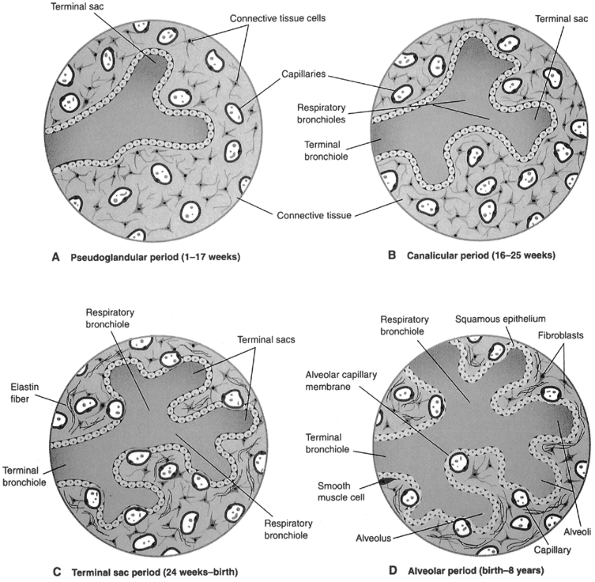 |
Fig. 2-4. Diagrammatic sketches of histologic sections, illustrating progressive stages of lung development. A, B. Note the rounded appearance of the air spaces, the abundance of interstitial tissue, and the distance from the capillaries to the air spaces. C, D. The alveolocapillary membrane is thin, and some capillaries bulge into the terminal sacs (future alveoli). From Moore KL, Persaud TVN: The Developing Human: Clinically Oriented Embryology. 6th Ed. Philadelphia: WB Saunders, 1998, p. 264. With permission. |
In contrast to type I pneumocytes, type II pneumocytes retain the glycogen of their cuboidal precursors. Campiche and colleagues (1963), as well as Sorokin (1966), identified eosinophilic lamellar bodies, which form from the Golgi apparatus and store phospholipid, in the cytoplasm of these cells by the end of the second trimester (Fig. 2-8). Subsequently, Meyrick and Reid (1973) noted that the type II pneumocytes begin production of phosphatidylcholine, a
P.21
precursor of the major surfactant phospholipid, dipalmitoyl phosphatidylcholine. In the mature lung, Farrell (1973) pointed out that this phospholipid is produced using the cytidine diphosphocholine (CDP-choline) pathway. The production of surface-active material from this pathway is influenced by a number of neural and hormonal factors, including the presence of surrounding mesenchyme, corticosteroids, and thyroxine (Fig. 2-9).
 |
Fig. 2-5. Histologic section showing the components of an acinus. A, muscular pulmonary artery; V, vein; TB, terminal bronchiole; RB, respiratory bronchiole; AD, alveolar duct; AS, alveolar sac. From Thurlbeck WM, Churg AM (eds): Pathology of the Lung. 2nd ed. New York: Thieme Medical Publishers, 1995, p. 15. With permission. |
Along with phospholipid, surfactant contains various apoproteins, carbohydrates, and cholesterol. This material coats the alveolus, creating a monolayer of fluid at the air cell interface. Von Neergaard (1929) observed that the effect of this monolayer is to reduce surface tension in the alveolus, preventing its collapse during expiration and reducing the elastic property of the lung by at least two thirds. Brumley and colleagues (1967) noted that sufficient quantities of surfactant are produced by 24 to 26 weeks to provide the alveolar stability required for gas exchange. Premature infants born at this stage of pulmonary development may therefore be viable, although exogenous surfactant is frequently required to lessen the morbidity and mortality of hyaline membrane disease.
Terminal Sac Phase
The terminal sac phase, which lasts from week 24 until birth, focuses on respiratory saccule development. By the beginning of the third trimester, three orders of respiratory bronchi can clearly be seen to originate from each terminal bronchiole. Loosely defined respiratory buds present at the beginning of the canalicular phase are now developed into several orders of distinct capillarized saccules. Throughout the terminal sac phase, the saccules continue to become septated. The septations create thin-walled subsaccular structures that will mature into true alveoli.
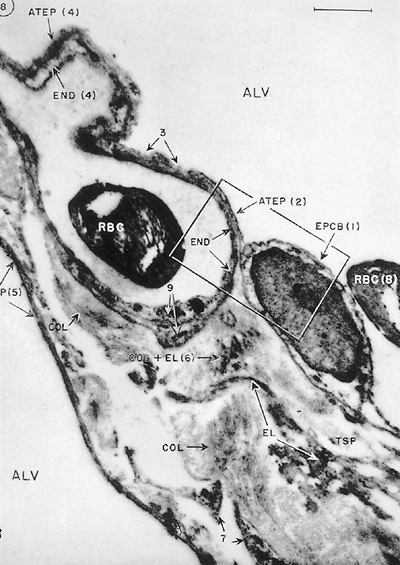 |
Fig. 2-6. Electron micrograph of the human alveolar wall. The epithelial cell body (1) attenuates (2) to cover the underlying capillary. The cellular duality of the blood air barrier is obscured at (3), but these layers are again distinguishable at (4). Both unit fibers of collagen (COL) and elastin (EL) are visible. From Low FN: The pulmonary alveolar epithelium of laboratory animals and man. Anat Rec 117:241, 1953. With permission. |
This transformation represents a continuum of development from saccule to alveolus, which has created a debate about the exact time when saccules become alveoli. Boyden (1967, 1972a) believed that the development of alveoli occurred postnatally and was dependent on the force of air movement within the lung. In his schema, therefore, the terminal sac phase is present until birth. Thurlbeck (1988) identified maturing alveoli prenatally during the third trimester and so divides the terminal sac phase into saccular and alveolar stages (Fig. 2-10). In either case, it is clear that most alveolar morphogenesis occurs postnatally. Based on lung morphometry studies by Weibel (1963) and Langston and colleagues (1984),
P.22
it is estimated that only 20 to 50 million alveoli, or 8% of alveoli present in adulthood, have formed by 40 weeks' gestation. A summary of the intrauterine development of the intrasegmental bronchial tree, including postnatal landmarks, is provided in Fig. 2-11.
 |
Fig. 2-7. Electron microscope studies of the human lung. A. Pseudoglandular phase showing tall columnar cell rich in glycogen. B. A cell becoming cuboidal. The capillary is now closer. C. Canalicular phase showing types 1 and 2 alveolar cells. The blood air barrier has formed. BL, basal lamina; Cap., capillary; Mes., mesenchymal cell. From O'Rahilly R, Muller F: Human Embryology and Teratology. 2nd Ed. New York: Wiley-Liss, 1996, p. 268. With permission. |
During the third trimester of gestation, respiratory movements have been identified, although they are intermittent. There has been considerable debate about the triggers of these motions, their role in pulmonary alveolar development, and their role in amniotic fluid production. The embryonic diaphragm, innervated by the phrenic nerve, does contract, although in utero this action produces paradoxical respiratory movement with chest contraction and abdominal distension. Windle and associates (1939) believed that intrauterine respiratory movements were a response to abnormally low fetal oxygenation as sensed by peripheral chemoreceptors. Later, studies conducted by Biscoe and colleagues (1969) and by Woodrum and colleagues (1977) on the lamb fetus showed that these movements were centrally controlled and do not depend on input from the carotid body chemoreceptors. It is now clear that fetal lung movements are mediated at the level of the brainstem.
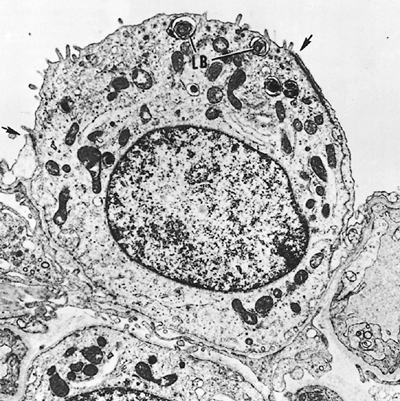 |
Fig. 2-8. Type II epithelial cell from a human lung. The alveolar surface is partially covered by flaps of cytoplasm from type I epithelial cells up to the intercellular junctions at the arrows. There are several lamellar bodies (LB) in the apical cytoplasm. Microvilli are present on the exposed apical surface (19,000 magnification). From Thurlbeck WM, Churg AM (eds): Pathology of the Lung. 2nd ed. New York: Thieme Medical Publishers, 1995, p. 18. With permission. |
The role of fetal lung movements in alveolar development is still debated. At one time, it was thought that these movements created a net inspiration of amniotic fluid and that this influx helped mold and form alveoli. It is now
P.23
known that the net movement of fluid is from the lung to the amnion. DeBlasio and colleagues (1960) demonstrated that aspiration of amniotic fluid does not occur in utero before labor. This fact has important clinical significance. Gluck and co-workers (1971) noted that the presence of increasing levels of pulmonary surfactant expelled from the lungs into the amniotic milieu during the third trimester allows for calculation of a lecithin-to-sphingomyelin ratio in fluid drawn at amniocentesis. This ratio is an accurate measure of fetal lung maturity and correlates with postnatal resistance to hyaline membrane disease in premature infants.
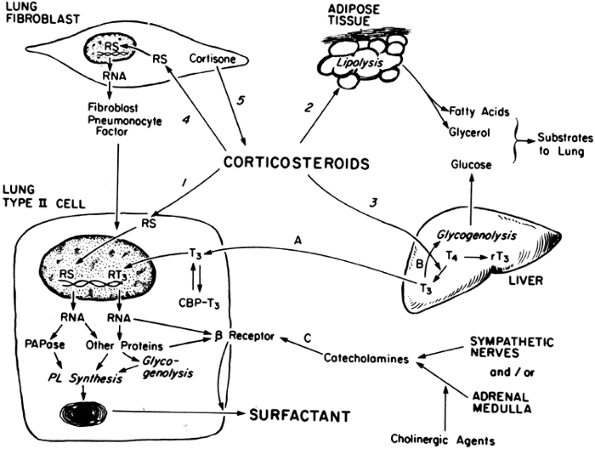 |
Fig. 2-9. Possible mechanisms by which glucocorticoids may influence fetal lung differentiation. RS, receptor-corticosteroid complex; CBP, cytosol-binding protein (for thyroid hormone); -receptor, -adrenergic receptor; PL, phospholipid. From Ballard PL: Hormonal regulation of the surfactant system. In Monset-Couchard M, Minkowski A (eds): Physiological and Biochemical Basis for Perinatal Medicine. Basel: Karger, 1981, p. 42. With permission. |
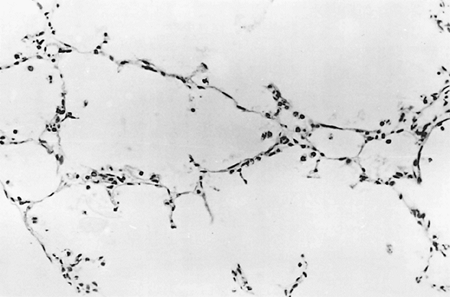 |
Fig. 2-10. Thirty-six weeks' gestation. Alveolar phase. Thin-walled alveoli are readily visible (hematoxylin and eosin stain; 200 magnification). From Langston C, et al: Human lung growth in late gestation and in the neonate. Am Rev Respir Dis 129:607, 1984. With permission. |
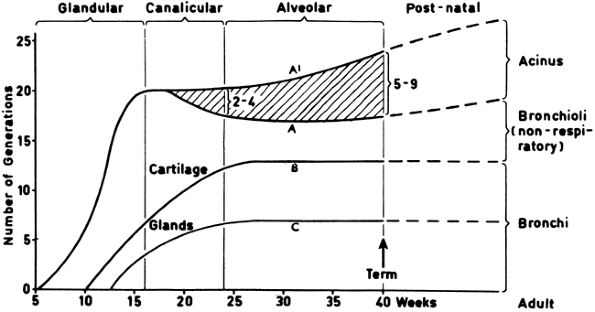 |
Fig. 2-11. Summary of intrauterine development of the intrasegmental bronchial tree. Line A represents the increase in the number of bronchial generations; shaded area between A and A1 represents the respiratory part of the bronchial tree (i.e., respiratory bronchioles and alveolar ducts). Line B shows the extension of cartilage along the bronchial tree, and line C, the extension of mucous glands. The diagram includes adult values, showing the increase in total generations in the postnatal period. From Bucher U, Reid L: Development of the intrasegmental tree; the pattern of branching and development of cartilage at various stages of intra-uterine life. Thorax 16:207, 1961. With permission. |
Pediatric Lung Maturation
Boyden and Tompsett (1965) and Dunnill (1962) are credited with the most complete analysis of postnatal lung maturation. Studying models and reconstructions of lung specimens from infants and children at several ages from 2 days of life to 7 years of age, these researchers were able to detail this important period of pulmonary development (Fig. 2-12). During the 1960s and 1970s, these researchers published a number of papers recording the results of these investigations. In 1974, Hislop and Reid, uniting this research to their knowledge of prenatal lung development, summarized pulmonary acinar development from the embryonic phase to adulthood (Fig. 2-13).
During their studies, Boyden and Tompsett (1965) identified two types of alveolar development that occur during the first several months of life. First, saccule walls continue to septate and thin, transforming greater numbers of alveolar primordia into mature alveoli. Second, alveolar ducts are created as transitional ducts, which link distal respiratory bronchioles to the saccules, becoming alveolarized. Alveolar development then progresses centripetally from the alveolar ducts toward the terminal bronchioles. The individual alveoli grow in size, but this growth is overshadowed by the rapid increase in the number of alveoli that form by these two mechanisms. Studying lung tissue from a child 1 year, 3 months of age, Dunnill (1962) estimated that 127 million alveoli had formed.
By 3 years of age, a third and final mechanism for postnatal alveolar development is identified. Boyden (1967), studying the superior lingual segment of a 3-year, 7-month-old child, found multiple diverticula arising from terminal bronchioles. The endothelium lining these new saccules was seen in various stages of metaplasia. The most mature of these saccules was lined with a thin epithelial layer, which was invaginated by a new capillary network resembling the canalization process in the embryo. Other saccules were lined by a transitional, low cuboidal epithelium, whereas relatively less developed saccules were lined by bronchiolar cuboidal epithelium. These new alveoli continue to form
P.24
and mature throughout early childhood, greatly increasing the total alveolar surface area for gas exchange.
 |
Fig. 2-12. Wax reconstructions of terminal air sacs in a 2-day-old infant (85 magnification). Note the shallowness and variations in size of the pulmonary alveoli that appear as smaller elevations on the surface of the terminal air sacs during the perinatal period. From Boyden EA, Tompsett DH: The changing patterns in the developing lungs of infants. Acta Anat 61:182, 187, 1965. With permission. |
 |
Fig. 2-13. Schematic representation of the growth of the acinus (subpleural). A. At 16 weeks' gestation, the airways terminate as a tubule close to the pleura. TB, terminal bronchiole. B. By 19 weeks' gestation, the last generation of airway shows thinned epithelium and forms the first respiratory bronchiolus (RB), and a second generation of respiratory bronchioli has formed by branching. C. By 28 weeks' gestation, three generations of respiratory bronchioli and one generation of transitional duct (TD) have arisen by further branching. The transitional duct gives rise to two primitive saccules (S). D. By birth, three generations of saccules are found, all ending in terminal saccules. No true alveoli are present, although indentations representing future alveoli are found. E. By 2 months of age, alveoli have developed in the walls of respiratory bronchioli, transitional ducts, and saccules. F. By 7 years of age, remodeling of respiratory bronchioli and alveolar ducts has occurred. Also, the terminal sac has formed the adult atrium (At), which has given rise to alveolar sacs (AS) that formed by budding. This pattern is similar to that found in the adult. Any further development is probably attributable to an increase in size. From Hislop A, Reid L: Development of the acinus in the human lung. Thorax 29:90, 1974. With permission. |
Two other important histologic features of alveolar morphogenesis have been identified in the pediatric lung. Lambert ducts, named after the anatomist who described them in 1955, are cuboidal cell lined tubes that connect alveolar units from adjacent respiratory segments. They have been identified in lung tissue from a child as young as 7 years old. Inhaled gases can traverse these ducts, allowing accelerated diffusion of these gases and equalization of air pressure between alveoli supplied by different terminal bronchioles. Lambert ducts differ from the pores of Kohn, first identified in 1893 by Dr. Kohn, which are much smaller and connect adjacent alveoli from the same respiratory segment. This movement speeds the diffusion of gases, improving the efficiency of gas exchange.
From 8 years old to adulthood, alveolar units continue to develop de novo but at a slower pace. Dunnill (1962) estimates that by 9 years old, 280 million alveoli are present. This is very near to the number of alveoli found in the adult lung. The total surface area of the alveoli at this age measures 32 m2. Throughout adolescence, individual alveolar size increases as the chest cavity increases in volume. Hislop and colleagues (1972) showed that the conducting airways keep pace during this period by both axial elongation and increase in diameter. As the alveolar elements enlarge, the area for gas exchange increases. Between 8 years and adulthood, the surface area of the lung doubles to 75 m2.
PULMONARY VASCULAR AND STROMAL EMBRYOGENESIS
Vascular Development
Knowledge of the basic structure of the aortae and the forming heart is key to the understanding of pulmonary vascular embryology. At 22 days (stage 10, 2 mm), there are paired dorsal aortae and a ventral aortic sac. The ventral aortic sac is contiguous with the cranial end of the heart tube, the truncus arteriosus. The dorsal aortae are connected to the ventral aortic sac through a series of paired aortic arches. Each arch corresponds to a pharyngeal pouch, which sits within and extends out from the triangle formed by the midline ventral aorta and the posterolateral paired dorsal aortae (Fig. 2-14).
The arches form progressively from craniad to caudad. At the 2-mm stage, only the first arch is present. At this point, the first arch provides the only connection from the dorsal aortae to the ventral aortic sac. Over the next several days of development, some arches regress, whereas others are transformed into more permanent structures. By the time the sixth arch appears at day 30 (stage 14, 6 mm), the first two arches have regressed. The third arch forms the common carotid arteries, and the fourth arch forms the aortic arch proper. The fifth arch is vestigial and regresses. It is the destiny of the sixth arch to form the proximal pulmonary arterial circulation (Fig. 2-15).
Near day 32 of fetal development, the sixth arch vessels give off primordial right and left pulmonary arteries (Fig. 2-16A). Over the next 2 weeks, a complex set of transformations occur in the sixth arch region. First, the dorsal portion of the right arch thins. The ventral portion of the left arch becomes the primordial main pulmonary artery, absorbing the ventral portion of the right sixth arch (see Fig. 2-16B). At the same time, the truncus arteriosus is being divided by
P.25
P.26
the aorticopulmonary septum isolating the pulmonary arterial blood source to the right ventricle. By day 50 (stage 20, 18 mm), the dorsal right sixth arch has regressed completely, and the ventral left sixth arch is firmly established as the main pulmonary artery. The dorsal left sixth arch remains, connecting the main pulmonary artery at its bifurcation to the left dorsal aorta as the ductus arteriosus (see Fig. 2-16C). Intrauterine development of the intrapulmonary portion of the pulmonary arterial system follows the branching pattern of the bronchi. By the completion of gestation, the pulmonary arteries supply all alveolar units and most of the visceral pleura.
 |
Fig. 2-14. The left lateral aspect of a model of the pharynx and branchial arch arteries in a 5-mm human embryo (after Congdon). The first and second arch arteries have retrogressed, the third and fourth arch arteries are complete, and the dorsal and ventral endothelial sprouts of the sixth (pulmonary) arch artery have nearly met. From the ventral sprouts, plexiform vessels pass to the lung bud. |
 |
Fig. 2-15. The left lateral aspect of a model of the pharynx and branchial arch arteries in an 11-mm human embryo (after Congdon). The sixth (pulmonary) arch artery is complete, and the third arch artery is bent cranially at its dorsal end, and its stream is about to be deflected in that direction. |
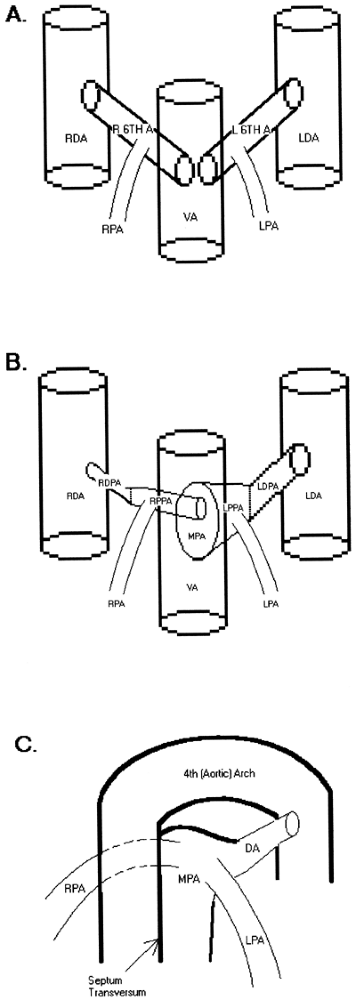 |
Fig. 2-16. Diagrammatic representation of pulmonary artery development from the right and left sixth aortic arches. A. By day 32 of development, the right and left sixth branchial arch arteries (R 6th A, L 6th A) have joined the respective dorsal aortae (RDA, LDA) to the ventral aortic sac (VA) and have given off primordial right and left pulmonary arteries (RPA, LPA). B. Near day 40, several changes are evident. The right distal sixth arch (RDPA) has thinned. The left proximal sixth arch (LPPA) has enlarged to include the right proximal pulmonary artery (RPPA), becoming the main pulmonary artery (MPA). C. By day 50, the transverse septum has divided the truncus arteriosus into right and left ventricular outflow tracts. The right dorsal aorta has regressed. The proximal left sixth arch has completed its transformation into the main pulmonary artery. The left distal pulmonary artery remains as the ductus arteriosus (DA), shunting the fetal right ventricular output away from the lungs into the systemic circulation. |
At birth, a rapid shift in pulmonary physiology occurs. Right ventricular blood is no longer shunted primarily through the ductus arteriosus. As the pulmonary vascular resistance decreases in response to high oxygen tension and vasoactive mediator release, as shown by Heymann and co-workers (1969), the pulmonary arteries receive most of the right ventricular output. At birth, most of the fluid that filled the airways in utero is expelled. Respiratory movements become regular, and air is inspired into the now patent airways. With perfusion of the pulmonary arteries and inspiration of air, gas exchange begins across the alveolar endothelium, and respiration is initiated. During infancy and childhood, the relative low-pressure state of the pulmonary arterial vasculature is preserved as the pulmonary arteries lose a considerable amount of their muscularity.
Development of the pulmonary venous system is only slightly less complex than that of the pulmonary arteries. Near day 22 (stage 11, 2.5 to 3.0 mm), bilateral primordial common pulmonary veins are seen exiting the sinoatrial region of the heart tube. By day 32 (stage 14, 6 to 7 mm), the pulmonary venous system is anastamosed to each lung bud vascular plexus bilaterally. The right and left main pulmonary veins then undergo a series of divisions. The most proximal of these divisions is resorbed, forming portions of the left atrium. Poddubnyi (1973) confirmed that by 9 weeks of development, the left atrium is well formed, and paired left and right pulmonary venous orifices are present. He also showed that as in the pulmonary arterial system, arborization of the intrapulmonary portion of the pulmonary venous system follows the bronchial template.
Before the formation of the pulmonary arteries and veins, both respiratory and nonrespiratory portions of the primordial lung are supplied by systemic connections, which anastomose the aortae to vascular plexuses that have formed from the pulmonary mesenchyme surrounding each lung bud. As the nonrespiratory portions of the bronchial tree develop, they continue to be vascularized by this foregut plexus from the aorta, which drains into the subcardinal veins and vena cavi. These systemic connections are lost later in development when formal connections are created to the systemic circulation in the form of bronchial arteries and veins. From weeks 20 to 32, the bronchial arteries and veins mature. When fully developed, the bronchial arteries supply the airway walls, the hilum, the hilar pleura, and large blood vessel walls. The bronchial venous system
P.27
drains a territory limited to the hilum, with the remainder of the lung and visceral pleura draining to the pulmonary circulation.
Innervation of the Lung
Development of the pulmonary nerve supply parallels the development of the airways and pulmonary blood vessels. Ectodermally derived neural crest cells migrate into the undifferentiated mesenchyme of the week-4 embryo. Nerve development then continues from hilum to periphery as target tissues develop with contributions from the vagus nerve and the thoracic sympathetic plexus. By week 7, extrachondral nerve bundles are seen in proximal airway walls. Later, subchondral plexuses are visualized in parallel to the extrachondral plexuses. In distal airways without cartilage, the two plexuses are seen to merge, finally terminating at the level of the terminal sacs, as reported by Larsell (1922).
By week 10, the extrapulmonary portion of the pulmonary arterial and venous trees is innervated. As intrapulmonary vascular connections mature, more peripheral arteries and veins are innervated. The nerves themselves receive a rich blood supply from the bronchial arteries. By 8 postnatal months, the entire nervous system is complete. At maturity, the pulmonary nervous system innervation includes airways from the trachea to the alveolus, airway appendages and epithelium including mucus glands, and peripulmonary tissues including blood vessels, lymphatics, and the visceral pleura.
Other Cell Types and Pulmonary Structures
Various cell types and structures not discussed previously are contributed to the developing lung by each embryologic dermal layer. Besides alveolar type I and type II pneumocytes, the endoderm differentiates in the conducting airways into ciliated cells, secretory goblet cells, intermediate cells, Clara cells, and basal cells. In more proximal airways, the cells take on a pseudostratified appearance, and subepithelial bronchial glands develop. The distal airways demonstrate a histologically simple epithelium and contain less secretory elements (Fig. 2-17). Besides blood vessels, the mesoderm contributes several structures, including cartilage, muscle, connective tissue, and lymphatics. Ectodermal derivatives include the pulmonary nervous system, as well as neuroendocrine derivatives such as the Kultschitzky cell and members of the amine precursor uptake and decarboxylation (APUD) family of neuroendocrine cells. According to Jeffery and Reid (1977), all of these cell types can be seen as early as week 16 of fetal lung development. Later in development, hematologic elements, including lymphocytes and mast cells, infiltrate the bronchial epithelium and are seen in the submucosal pulmonary parenchyma.
 |
Fig. 2-17. The change of airway wall structure at the three principal levels. The epithelial layer (EP) gradually becomes reduced from pseudostratified to cuboidal and then to squamous but retains its organization as a mosaic of lining and secretory cells. The smooth muscle layer (SM) disappears in the alveoli. The fibrous coat (FC) contains cartilage only in bronchi and gradually becomes thinner as the alveolus is approached. BM, basement membrane. From Weibel ER: The Pathway for Oxygen. Cambridge: Harvard University Press, 1984. With permission. |
FUTURE DIRECTIONS
The field of pulmonary embryology remains active. It has progressed far beyond the level of wax model reconstructions and light microscopy. Technologic advances, including transgenic mouse models, have allowed modern embryologists a view of lung development at the molecular level. Much of the current work on lung development is focused on signaling pathways and the role of growth factors in morphogenesis and cytodifferentiation.
It is now clear that there is heterogeneous expression of signaling pathways, growth factors, and their receptors along the bronchial tree. For example, knock-out mouse experiments by Kimura (1996) and Morrissey and colleagues (1998), respectively, have proved the pivotal role that transcriptional pathways such as thyroid transcription factor-1 (TTF-1) and GATA-6, play in lung morphogenesis. Growth factors, including epidermal growth factor (EGF), transforming growth factor- 2 (TGF- 2), endodermal bone morphogenic protein 4 (BMP-4), and mesenchymal fibroblast growth factor-10 (FGF-10), interact with these pathways to effect both proximal and distal cell differentiation, as shown by Chinoy (1998), Minoo (1995), Bellusci and co-workers (1996, 1997). The release of vascular endothelial growth factor (VEGF) by respiratory epithelium has been identified as a key factor in the development of the capillary network that forms the air blood barrier by Ferrara and associates (1991). These are but a few of the countless interactions that lead to the development of a functional and mature lung.
As we gain a better understanding of these complex interactions, it is hoped that this work will yield therapeutic strategies in a number of clinical settings. Obvious application for this translational research is in the field of neonatology
P.28
and in children with pulmonary developmental abnormalities. Both pediatric and adult patients with pulmonary parenchymal injury may benefit from research aimed at lung regeneration and healing. Finally, mutations in the genes that normally regulate lung development may be implicated in the formation of pulmonary malignancy.
REFERENCES
Ballard PL: Hormonal regulation of the surfactant system. In: Monset-Couchard M, Minkowski A (eds): Physiological and Biochemical Basis for Perinatal Medicine. Basel: Karger, 1981, p. 42.
Bellusci S, et al: Evidence from normal expression and targeted misexpression that bone morphogenic protein (BMP-4) plays a role in mouse embryonic lung morphogenesis. Development 122:1693, 1996.
Bellusci S, et al: Fibroblast growth factor 10 (FGF-10) and branching morphogenesis in the embryonic mouse lung. Development 124:4867, 1997.
Biscoe TJ, Purvis MJ, Sampson SR: Types of nervous activity which may be recorded from the carotid sinus nerve in the sheep fetus. J Physiol 190:443, 1969.
Boyden EA: Notes on the development of the lung in infancy and early childhood. Am J Anat 121:749, 1967.
Boyden EA: Development of the human lung. In: Brennermann's Practice of Pediatrics. Vol. 4. Hagerstown, MD: Harper&Row, 1972a.
Boyden EA: The structure of compressed lungs in congenital diaphragmatic hernia. Am J Anat 134:497, 1972b.
Boyden EA: The mode of origin of pulmonary acini and respiratory bronchioles in the fetal lung. Am J Anat 141:317, 1974.
Boyden EA, Tompsett DA: The changing patterns in the developing lungs of infants. Acta Anat 47:185, 1965.
Bremer JL: The diaphragm and diaphragmatic hernia. Arch Pathol 36:539, 1943.
Brumley GW, Hodson WA, Avery ME: Lung phospholipids and surface tension. Correlations in infants with and without disease, and in adults. Pediatrics 40:13, 1967.
Bucher U, Reid L: Development of the intrasegmental tree; the pattern of branching and development of cartilage at various stages of intrauterine life. Thorax 16:207, 1961.
Campiche MA, et al: An electron microscope study of the fetal development of the lung. Pediatrics 32:976, 1963.
Chinoy MR, et al: Influence of epidermal growth factor and transforming growth factor beta-1 on patterns of fetal mouse lung branching morphogenesis in organ culture. Pediatr Pulmonol 25:244, 1998.
DeBlasio A, Ambrosio G, D'Amora G: Sui movimenti respiratori endouterini del feto umano a termine. Pediatria 68:1124, 1960.
Dubreuil G, et al: Observations sur le developpement du poumon humain. Bull Histol Technol Physiol 13:235, 1936.
Dunnill MS: Postnatal growth of the lung. Thorax 17:329, 1962.
Farrell PM: Regulation of pulmonary lecithin synthesis. In: Villee CA, Villee DB, Zuckerman J (eds): Respiratory Distress Syndrome. New York: Academic Press, 1973.
Ferrara N, Winer J, Burton T: Aortic smooth muscle cells express and secrete vascular endothelial growth factor. Growth Factors 5:141, 1991.
Gluck L, et al: Diagnosis of the respiratory distress syndrome by amniocentesis. Am J Obstet Gynecol 109:440, 1971.
Heymann MA, et al: Bradykinin production associated with oxygenation of the fetal lamb. Circ Res 25:521, 1969.
Hislop A. et al: Postnatal growth and function of the pre-acinar airways. Thorax 27:265, 1972.
Hislop A, Reid L: Development of the acinus in the human lung. Thorax 29:90, 1974.
Hugues GM: Evolution between air and water. In: De Reuck AVS, Potter R (eds). Ciba Foundation Symposium: Development of the Lung. Boston: Little, Brown, and Co, 1967.
Jeffery PK, Reid L: Ultrastructural features of airway lining epithelium in the developing rat and human lung. J Anat 120:295, 1977.
Kimura S, et al: The T/ebp null mouse: thyroid-specific enhancer-binding protein is essential for the organogenesis of the thyroid, lung, ventral forebrain, and pituitary. Genes Dev 10:60, 1996.
Kohn HM: Zur histologie der inderevenden fibrosen Pneumonie. Munch Med Wochenschr 40:42, 1893.
Krogh A: On the cutaneous and pulmonary respiration of the frog: a contribution to the theory of gas exchange between the blood and the atmosphere. Skand Arch Physiol Leipz 15:328, 1904.
Lambert MW: Accessory bronchioli-alveolar communications. J Pathol Bacteriol 70:311, 1955.
Langston C, et al: Human lung growth in late gestation and in the neonate. Am Rev Respir Dis 129:607, 1984.
Larsell O: The ganglia, plexuses and nerve terminations of the mammalian lung and pleura pulmonalis. J Comp Neurol 35:97, 1922.
Loosli CG, Potter EL: The prenatal development of the human lung. Anat Rec 109:320, 1951.
Low FN: The pulmonary alveolar epithelium of laboratory animals and man. Anat Rec 117:241, 1953.
Meyrick B, Reid L: Electron microscopic aspects of surfactant secretion. Proc R Soc Med 66:386, 1973.
Minoo P, et al: TTF-1 regulates lung epithelial morphogenesis. Dev Biol 172:694, 1995.
Moore KL, Persaud TVN: The Developing Human: Clinically Oriented Embryology. 6th Ed. Philadelphia: WB Saunders, 1998, p. 259.
Morrissey EE, et al: GATA-6 regulates HNF4 and is required for differentiation of visceral endoderm in the mouse embryo. Genes Dev 12:79 3590, 1998.
O'Rahilly R, Boyden EA: The timing and sequence of events in the development of the human respiratory system during the embryonic period proper. Z Anat Entwicklungsgesh 141:237, 1973.
O'Rahilly R, Muller F: The respiratory system. In: Human Embryology and Teratology. 2nd Ed. New York: Wiley-Liss, 1996.
Pattle RE, Hopkinson DAW: Lung lining in bird, reptile, and amphibia. Nature 200:894, 1963.
Poddubnyi IG: Embryonic development of the pulmonary veins. Arch Anat Histol Embryol 64:49, 1973.
Policard A, et al: L'alveole pulmonaire au microscope electronique. Presse Med 62:1775, 1954.
Rudnick D: Developmental capacities of the chick lung in chorioallantoic grafts. J Exp Zool 66:125, 1933.
Smith EI: The early development of the trachea and esophagus in relation to atresia of the esophagus and tracheoesophageal fistula. Contrib Embrol Carnegie Inst Wash 36:41, 1957.
Sorokin SP: A morphologic and cytochemical study on the great alveolar cell. J Histochem Cytochem 14:884, 1966.
Streeter GL: Developmental horizons in human embryos: description of age group XI, 13 to 20 somites and age group XII, 21 to 29 somites. Contrib Embryol Carnegie Inst Wash 30:211, 1945a.
Streeter GL: Developmental horizons in human embryos: description of age group XIII and XIV. Contrib Embryol Carnegie Inst Wash 31:27, 1945b.
Streeter GL: Developmental horizons in human embryos: description of age group XI, 13 to 20 somites and age groups XV, XVI, XVII, and XVIII. Contrib Embryol Carnegie Inst Wash 32:133, 1948.
Streeter GL: Developmental horizons in human embryos: description of age group XI, 13 to 20 somites and age groups XIX, XX, XXI, XXII, and XXIII, being the fifth issue of a survey of the Carnegie collection prepared for publication by Herser CH, Corner GW. Contrib Embryol Carnegie Inst Wash 34:165, 1951.
Taderera JV: Control of lung differentiation in vitro. Dev Biol 16:489, 1967.
Thurlbeck W: Lung growth. In: Pathology of the Lung. New York: Thieme, 1988.
Thurlbeck WM, Churg AM (eds): Pathology of the Lung. 2nd Ed. New York: Thieme Medical Publishers, 1995, p. 15.
von Neergaard K: Neue auffassungen uber einen grundbergergriff der atemmechanik: Die retraktionskraft der lunge, abhangig von der oberflachenspannung in den alveolen. Z Gestamte Exp Med 66:373, 1929.
Weibel ER: Morphometry of the Human Lung. Berlin: Springer-Verlag, 1963.
Weibel ER: The Pathway for Oxygen. Cambridge: Harvard University Press, 1984.
Windle WF, et al: Aspiration of amniotic fluid by the fetus: an experimental roentgenological study in the guinea pig. Surg Gynecol Obstet 69:705, 1939.
Witschi E: Development of Vertebrates. Philadelphia: WB Saunders, 1956.
Woodrum DE, et al: Initiation of breathing in the fetal lamb: response to cyanide, hypoxemia and hypercapnia following peripheral denervation. J Appl Physiol 42:630, 1977.
Zackary RB, Emery JL: Failure of separation of larynx and trachea from the esophagus: persistent esophagotrachea. Surgery 49:525, 1961.
EAN: 2147483647
Pages: 203